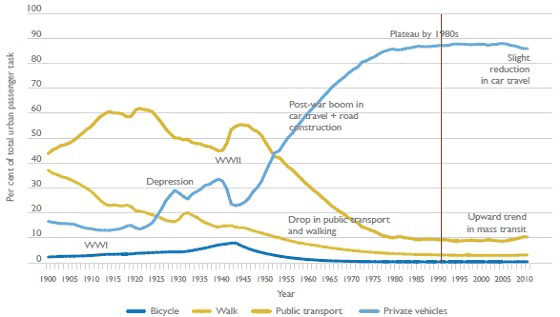A new paper on the effects of mandatory bicycle helmets on cycling by children and teenagers in the US has created a lot of buzz among those interested in this arcane and contentious subject. The headline finding is the mandatory helmet law is associated with a 13% reduction in head injuries for five- to 19-year-olds. But it’s also associated with a 9% reduction in cycling by this age group. The authors go further with the novel contention that helmet laws are also associated with an 11% increase in injuries among five- to 19-year-old users of skateboards, roller skates and scooters (although the absolute numbers are much smaller).
The study’s been tweeted by a number of respectable academics, implying it’s a serious paper with important findings. I suspect most of them have only read the abstract (although Robin Hanson appears to have read more).
The study, Effects of bicycle helmet laws on children’s injuries, was done by Pinka Chatterji of the State University of New York at Albany and Sara Markowitz of Emory University in Atlanta. Some 21 US states have introduced compulsory helmet laws for children since 1987, and the authors examined bicycle-related injuries over a total period of 17 years at a sample of 141 hospitals in 42 states, including 16 states with helmet laws. This is a complex exercise, as states introduced laws at different times. Moreover, there are multiple age cut-offs across the states examined in the study — under five, nine, 12, 13, 14, 15, 16, 17 and 18 years of age.
Exactly how the researchers went about their task isn’t as clearly expressed as it should be, but from what I can make out, they started with a hospital-level database of injuries associated with consumer products. They compared injuries in the year before the law was introduced in each state with those in the year after (there are multiple dates and cut-offs in some states). They compared these findings with what happened in states without helmet laws.

Historical cycling trend in Australian capital cities: the red line shows when helmets were mandated (Source: DoIT)
Putting aside any caveats about the methodology, the authors make an important point. They say there are three possible explanations for the identified 13% reduction in head injuries. One is that more riders wear helmets and enjoy the protective effect. Another is the law means fewer children cycle, ie. the deterrent effect of making helmets mandatory. A third possibility, though, is that children are cycling more safely due to the publicity associated with the introduction of the helmet law. This explanation is especially interesting in light of the debate in Australia.
It suggests that it might be the heightened perception of danger that’s more important than the helmet law per se, eg. fearful parents don’t permit their children to cycle to school even with a helmet.
This could be the basis of an argument that the helmet laws aren’t necessary. Or it could be used to argue that repealing the law would make little difference.
The authors, however, conclude that the deterrent effect is the key explanation, arguing helmet laws may induce “a substitution effect away from bicycle riding towards the other wheeled sports”.
It’s an interesting correlation but their justification is cursory at best. There are other explanations to check out first, eg. perhaps the hospitals sampled in helmet law states are, on average, in more urban settings that present riskier conditions for skate boarders?
I’m a little surprised some anti-helmet law advocates are publicising this study. The estimate of a 9% reduction in cycling due to helmet laws is modest compared to claims of a 30-40% reduction among children in Australia when the law was introduced.
Smith and Milthorpe and Finch, Heiman and Neiger reported much larger falls than 9% among children and teenagers in NSW and Victoria respectively in the first year following introduction of the law (with much smaller falls among adults).
Taking the study at face value, it’s worth asking if a 9% reduction in cycling is justified by a 13% reduction in head injuries. That would depend in part on the severity of the head injuries and on what those children/teenagers who are deterred from cycling do instead (skate-boarding?).
I think all those involved in the debate on the mandatory helmet law in Australia should be cautious about how much weight they give to these findings.








Crikey encourages robust conversations on our website. However, we’re a small team, so sometimes we have to reluctantly turn comments off due to legal risk. Thanks for your understanding and in the meantime, have a read of our moderation guidelines.